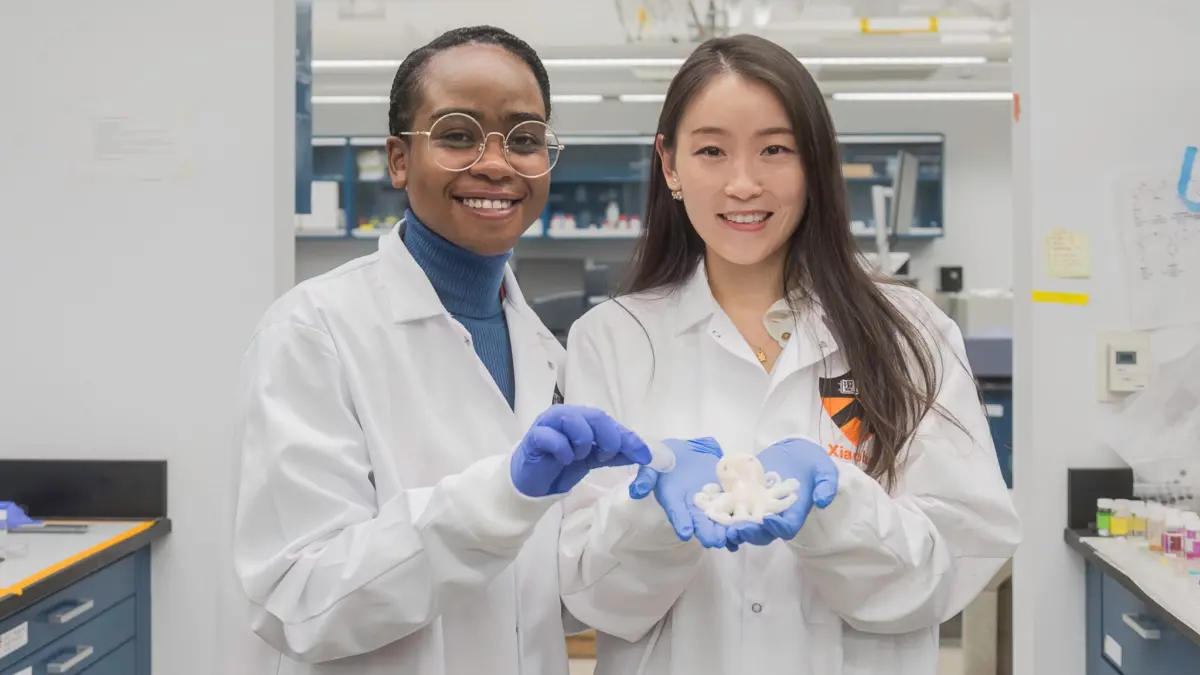
Reusable and recyclable, this new hydrogel squishes the old version’s environmental impact
Princeton researchers have created a new type of hydrogel that is recyclable, yet still tough and stable enough for practical use (and reuse).
As flexible networks of polymer chains suffused by water, hydrogels possess excellent properties including softness, elasticity and biocompatibility. Accordingly, the squishy materials have already found widespread use as contact lenses and wound dressings. Hydrogels also hold great promise for drug delivery systems, agriculture and food packaging, among other applications.
Unfortunately, conventional hydrogels pose environmental pollution problems because they cannot be effectively recycled or reprocessed. Hydrogels also degrade from long-term use. The researchers said these limitations derive from the materials’ structure. Conventional hydrogels rely on chemical bonds for their firmness and ability to soak up water and other solvents. On a chemical level, these bonds are cross-linked, meaning that bonds form among different polymer molecules within the hydrogel. This cross-linking, characteristic of resins undergoing curing or rubber vulcanization, gives hydrogels flexibility and strength. But it also makes them extremely difficult to separate into components for recycling.
The study’s lead author, Xiaohui Xu, a postdoctoral researcher, previously worked with hydrogels for use in water purification and wondered if she could create a more environmentally sustainable hydrogel. Xu and her colleagues took a new approach to building hydrogels. Rather than relying on chemical bonds to connect different polymers, the researchers decided to harness phase separation, a familiar phenomenon in which mixed liquids, such as oil and water, separate into components.

“Hydrogels offer tremendous societal benefit, but their lack of sustainability has loomed as a significant issue,” said Xu, a postdoctoral researcher in the lab of Rodney Priestley, the Pomeroy and Betty Perry Smith Professor of Chemical and Biological Engineering at Princeton. “In this study, we have shown how taking advantage of phase separation can lead to new kinds of hydrogels that are durable and recyclable and still have good mechanical properties.”
The researchers described the process in a study published in the Journal of the American Chemical Society Au in September.
To make the new hydrogel, the researchers formulated polymers with a complex and varying relation to water. Polymer molecules are long chains of smaller molecules (called monomers). The researchers created polymers that are water-loving in some sections of the chain and water-repelling in other sections. When they added water to the polymer mix, parts of the polymers absorbed the water, while other parts repelled it. This tension gave the hydrogel its structural strength. Unlike conventional hydrogels, the strength is based on physical characteristics rather chemical bonds among the polymers. So, recycling the hydrogel into its component polymers is relatively easy, as is repeatedly dehydrating and rehydrating the material.
What is more, Xu said, the process allows engineers to tailor the characteristics of a hydrogel by adjusting the components of the polymers. The research team took advantage of this to create a hydrogel that could be cut and molded into any desired shape. For the research, Xu made an octopus.
“Xiaohui used phase separation as a way to control the morphology, and ultimately, the properties of these hydrogel materials,” said Priestley, the paper’s senior author and Dean of the Graduate School at Princeton. “This work demonstrates an environmentally friendly approach for making tough and reusable hydrogels.”
The Princeton researchers put the new hydrogel through its paces, testing its stability in extreme acidic and alkaline conditions and in air and water. Across the board, the hydrogel held up and performed as expected.
With additional testing and development, the novel material could make existing and emerging applications for hydrogels — such as artificial muscles and soft robots for safe operation around humans — more sustainable and environmentally friendly.
“Our general approach for recyclable hydrogels could help expand their applications in all kinds of areas,” said Xu. “The benefits of hydrogels can now be better realized without the environmental costs.”
Xu said in the long term, the research team is exploring whether hydrogels could eventually serve as a substitute for plastics in many applications. If that is the case, advanced hydrogels could become a recyclable solution to plastic pollution that threatens the oceans.
The paper, “Tough and Recyclable Phase-Separated Supramolecular Gels via a Dehydration–Hydration Cycle,“ was published Sept. 21 in the Journal of the American Chemical Society Au. In addition to Xu and Priestley, other Princeton authors on the study were former graduate student Yannick Eatmon; former postdoctoral researcher Kofi Christie, now an assistant professor at Louisiana State University; postdoctoral fellow Allyson McGaughey; graduate student Néhémie Guillomaitre; Sujit Datta, an associate professor of chemical and biological engineering; Zhiyong Jason Ren, professor of civil and environmental engineering and the Andlinger Center for Energy and the Environment; and Craig Arnold, the Susan Dod Brown Professor of Mechanical and Aerospace Engineering. The work was supported by the National Science Foundation and a National GEM Consortium Fellowship.
This story originally appeared on the School of Engineering and Applied Science website.